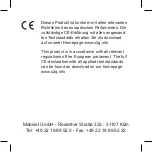
When used in the directed manner, this unit has been designed and manufactured to ensure your personal safety. However, improper use can result
in potential electrical shock or fire hazards. Please read all safety and operating instructions carefully before installation and use, and keep these
instructions handy for future reference. Take special note of all warnings listed in these instructions and on the unit.
1.
Water and Moisture
– This unit is rated iP67 (will withstand submersion for 30 minutes at a depth of 1 meter (3 feet)), but should not be operated
under water. It is also dustproof.
• Waterproof door cover must be properly sealed before use near water.
• Dry unit completely before opening waterproof door cover.
• Do NOT open waterproof door cover if wet or in a wet environment.
2.
Ventilation
– The unit should be situated so that its location or position does not interfere with its proper ventilation. For example, it should not be
situated on a bed, sofa, rug or similar surface that may block ventilation openings. Also, it should not be placed in a built-in installation, such as
a bookcase or cabinet, which may impede the flow of air through the ventilation openings.
3.
Heat
– The unit should be situated away from heat sources such as radiators, heat registers, stoves or other appliances (including amplifiers) that
produce heat.
4.
Power Sources
– The unit should be connected to a power supply only of the type described in the operating instructions or as marked on the
appliance.
5.
Power-Cable Protection
– Power supply cables should be routed so that they are not likely to be walked on or pinched by items placed upon or
against them.
6.
Cleaning
– The unit should be cleaned only using a warm damp cloth. Do not use solvents, etc.
7.
Objects and Liquid Entry
– Care should be taken so that objects do not fall and liquids are not spilled into any openings or vents located on the
product.
8.
Attachments
– Do not use attachments not recommended by the product manufacturer.
9. L
ightning and Power Surge Protection
– Unplug the unit from the wall socket and disconnect the antenna or cable system during a lightning
storm or when it is left unattended and unused for long periods of time. This will prevent damage to the product due to lightning and power-line
surges.
10.
Overloading
– Do not overload wall sockets, extension cords, or integral convenience receptacles as this can result in a risk of fire or electric
shock.
11.
Damage Requiring Service
– The unit should be serviced by qualified service personnel when:
A. the power supply cable or plug has been damaged.
B. objects have fallen into or liquid has been spilled into the enclosure..
C. the unit has been dropped or the enclosure damaged.
D. the unit exhibits a marked change in performance or does not operate normally.
12.
Periods of Nonuse
– If the unit is to be left unused for an extended period of time, such as a month or longer, make sure to charge the unit before
storing and periodically during storage to maintain battery
13.
Servicing
– The user should not attempt to service the unit beyond those methods described in the user’s operating instructions. Service methods
not covered in the operating instructions should be referred to qualified service personnel.
Consumer Product Safety Guide
12
IMPORTANT SAFETY INSTRUCTIONS

































